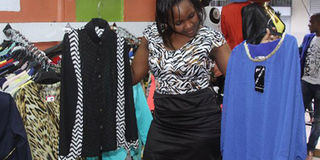Why fashion trends remain irrelevant to most Kenyans

Rarely is what you wear going to be an act of self-expression, individuality, fun and pure enjoyment. PHOTO | NATION MEDIA GROUP
What you need to know:
- Women appreciate TV anchor style. But inspiration must be grander for a homemade aesthetic to blow up a trend. That way other people’s culture holds less stock in our wardrobes.
- The average person weighs in other people’s opinions like the pastor, church communities, soon-to-be or existing in-laws and significant others, social media, other women, body shape.
- Rarely is what you wear going to be an act of self expression, individuality, fun and pure enjoyment. Not when approval ratings rise and soar based on the #OOTD (“Outfit Of the Day”) .
The beauty of spending weeks away from the city is the realisation that my entire career as a fashion and lifestyle journalist only matters if I can make it rain! Since I lack the ability to make things grow I savoured endlessly hot days and quiet, still nights away from my makeup kit, polarising wardrobe and Nairobi’s thrumming social scene.
Instead, I was barefoot in khangas and large, floppy hats. It was beautifully instructive because flipping through countdowns for best and worst, it occurred to me it really did not matter what the biggest 2016 fashion trends will be. Kenyans will in their unique enthusiasm find a way to ruin it. Here’s how.
1. Everything is hot especially because:
a) All the fashion magazines from here to Mars still say it is so
b) You will insist on what you want to wear anyway and fashion be damned
c) Fashion is what is affordable
d) The noughties are specifically vague when it comes to trends; so everything from the 1920s to 2017 is trendy
e) You will still wear what you were wearing in 2012
f) The average number of years we keep our clothes according to a 2015 P&G research is 12 years.
2. Kenya is a conservative, pretentious state.
Yes, we all know this to be true so can we simply accept and move past it. The average person weighs in other people’s opinions like the pastor, church communities, soon-to-be or existing in-laws and significant others, social media, other women, body shape. Rarely is what you wear going to be an act of self expression, individuality, fun and pure enjoyment.
Not when approval ratings rise and soar based on the #OOTD (“Outfit Of the Day”) . Fashion then remains the preserve of ballsy characters like Sauti Sol or other interesting artistes who are surprisingly almost always male and fashionistas living on the edge.
3. Any trend picking steam is worn till it disintegrates. Kenyans have the ability to extend trends by two to five years.
The double slit dress, peplum, skinny jeans and leggings will probably disappear with the next generation.
4. Kenyans have a repeated, constant need to opt for the safest, most mundane, most boring fashion choices picking function over style.
5. Kenyans will continue to lament that:
a) They don’t know any local designers
b) They know some but must they be so expensive?
c) Also, isn’t their print aesthetic all the same?
d) Besides, even if this were not so, designers outfits are too distinct and can only be worn once
e) And so what if I trawl Ankara sites, take screenshots and share with my tailor or designer to make a replica that 67 other women are wearing. At least I am still proudly Kenyan, right?
6. Trend assimilation has something of a graph spreading the seed of a trend.
Locally it is a series of broken links. Ideally trends start from the street. The pulse of pop culture is fed with anything from lifestyle, music, art, sports, personalities, dance and movement, TV, theatre to film. We shop because it was on Empire, The Wire, Game of Thrones, House of Cards to Scandal. Fashion houses, retail outlets and celebrities curate tipping points, things so culturally relevant the world has to pay attention. It is how trends are born.
Kenya lacks this cycle and relationship. It blips on a small scale. Women appreciate TV anchor style. But inspiration must be grander for a homemade aesthetic to blow up a trend. That way other people’s culture holds less stock in our wardrobes.
Muses across the spectrum from the intensely bizarre creativity of a Lady Gaga, a fearless Rihanna feeding trends to the masses, a Zendaya or Suraya giving teens and young adults access to fashion to a reel and real life hybrid Olivia Pope/Kerry Washington and Claire Underwood/Robin Wright influencing wardrobes of powerful career women are key.
Muses feed magazine publishing and fashion media with content.
7. Sadly, Kenyans will do what they’ve always done, buying off stalls curating looks for them, deprived of opportunities to sweat out their own style, negotiating to take home what other people think of them.





